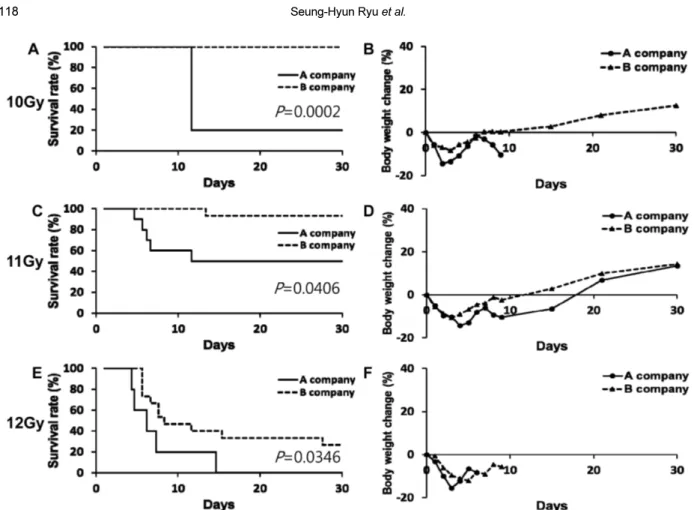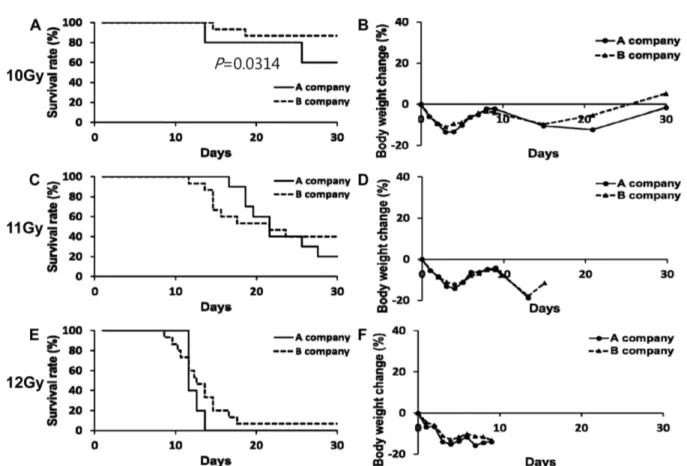Lab Anim Res 2016: 32(2), 116-121 http://dx.doi.org/10.5625/lar.2016.32.2.116
ISSN 2233-7660 (Online)
Establishment of a mouse model of 70% lethal dose by total-body irradiation
Seung-Hyun Ryu
1,#, Jong-Hyung Park
1,#, Eui-Suk Jeong
1,2, Soo-Young Choi
1, Seung-Hoon Ham
1, Jin-Il Park
1, Hee-Yeon Jeon
1, Jun-Young Kim
1, Ran-Ji Yoo
3, Yong-Jin Lee
3, Sang-KeunWoo
3, Yang-Kyu Choi
1,*
1
Department of Laboratory Animal Medicine, College of Veterinary Medicine, Konkuk University, Seoul, Korea
2
Laboratory Animal Center, Daegu-Gyeongbuk Medical Innovation Foundation, Daegu, Korea
3
Molecular Imaging Research Center, Korea Institute of Radiological and Medical Sciences, Seoul, Korea
Whereas increasing concerns about radiation exposure to nuclear disasters or side effects of anticancer radiotherapy, relatively little research for radiation damages or remedy has been done. The purpose of this study was to establish level of LD70/30 (a lethal dose for 70% of mice within 30 days) by total-body γ irradiation (TBI) in a mouse model. For this purpose, at first, 8-week-old male ICR and C57BL/6N mice from A and B companies were received high dose (10, 11, 12 Gy) TBI. After irradiation, the body weight and survival rate were monitored for 30 days consecutively. In next experiment, 5-week-old male ICR and C57BL/6N mice from B company were received same dose irradiation. Results showed that survival rate and body weight change rate in inbred C57BL/6N mice were similar between A and B company. In ICR mice, however, survival rate and body weight change rate were completely different among the companies.
Significant difference of survival rate both ICR and C57BL6N mice was not observed in between 5-week- old and 8-week-old groups receiving 10 or 12 Gy TBI. Our results indicate that the strain and age of mice, and even purchasing company (especially outbred), should be matched over experimental groups in TBI experiment. Based on our results, 8-week-old male ICR mice from B company subjected to 12 Gy of TBI showed LD70/30 and suitable as a mouse model for further development of new drug using the ideal total-body irradiation model.
Keywords: Total-body irradiation, LD70/30, mice, model
Received 9 May 2016; Revised version received 27 May 2016; Accepted 31 May 2016
Ionizing radiation is a type of energy composed of electromagnetic waves, like X-rays or γ-rays, and particles, like alpha, beta, or neutron particles. Ionizing radiation has extensive effects on rapidly proliferating cell populations, such as intestinal stem cells or proliferative crypt epithelial cells [1]. Additionally, the toxicity of ionizing radiation can induce multiple organ dysfunction syndromes, such as cerebrovascular syndrome, gastrointestinal syndrome, and hematopoietic syndrome. Depending on the absorbed dose, damaged tissues or organs could lead to acute radiation syndrome and eventually death within 30 days
[2-4].
Such radiation exposure has been observed after nuclear disasters, e.g., nuclear war or terrorism, or for medical diagnostic machines, including X-rays, nuclear medicine, and radiotherapy. In the case of large-scale nuclear disasters, such as the Fukushima and Chernobyl nuclear disasters, which generate a large number of casualties, including military personnel and civilians, plans for the medical management of radiation exposure damage are needed [5]. In addition, despite a lack of effective therapeutic agents for the side effects of cancer
#

